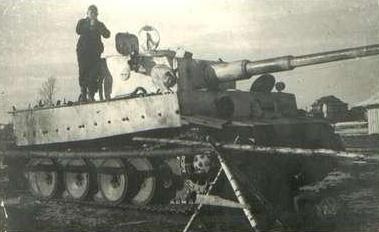Good images Mckenny
First tigers on the Eastern Front:
[LEFT]
The first appearance of the Tiger on the Eastern Front was unsuccessful. The first Tigers were issued to the 1st platoon of the 502 Battalion of Heavy Tanks (Schwere Panzer Abteilung 502). On the 29th of August 1942, the four Tigers arrived at the Mga railway station near Leningrad. Early that day, the tanks were unloaded and prepared for battle. At 11:00 AM, the Tigers went into their battle positions. Major Richard Merker commanded the platoon, which included four Tigers, six PzKpfw III Ausf. L and J, two infantry companies and several trucks of the technical support unit. A representative of the Henshel firm - Hans Franke accompanied this unit in a VW Kubelwagen right behind the first Tiger. After the attack, the error in trying to use the heavy Tiger in ground so soft was realized, for their maneuverability was hampered.
[/LEFT]
The elephant badge of the S.Pz.Abt 502:
[LEFT]
The Russian infantry retreated, and their artillery opened heavy fire to cover the troops. Major Merker’s unit, divided into two groups, started to attack on two parallel side roads. Very soon the first Tiger was abandoned because of transmission failure. The second one was abandoned a few minutes later after engine failure. In spite of Russian fire, the Henschel representative started to inspect the tanks, but very soon Merker came by with his Tiger and said that the third tank was disabled because the steering control failed. During the night, all three damaged Tigers were evacuated using Sd Kfz 9 prime movers-three per tank. Fortunately for the Germans, the Russians could not take any action to capture the disabled tanks. After the inspection, spare parts for the Tigers were delivered by plane from the Henshel plant in Kassel and on the 15th of September all four Tigers were repaired and ready for action. [/LEFT]

[LEFT]
The second action of the Tigers was no better than the first. On the 22nd of September, four Tigers, supported by PzKpfw III tanks, were to accompany the 170th Infantry Division in attacking the 2nd Soviet Army. The terrain was very bad, the ground was too soft after the rains, and Major Merker opposed the use of Tigers in this operation. After a direct order from Hitler, the Tigers went into battle. Very soon after the attack began, the first Tiger received a direct hit in the front armor plate. The shell did not penetrate, but the engine stopped and there was no time to restart it. The crew abandoned the Tiger and threw hand grenades into the fighting compartment. The other three Tigers reached the Russian trenches, but very soon were damaged by Russian artillery crossfire as they lost maneuverability on the soft ground. Later on, the three Tigers were evacuated, and German engineers destroyed the fourth in order to prevent its capture.
[/LEFT]
[LEFT]General Guderian: “It was not only the heavy losses, it was the loss of secrecy and suprise in the future”.
The Tigers were successful in their third battle. On the 12th of January 1943, the 502nd supported the 96th Infantry Division opposing an attack of Russian tanks. Four Tigers destroyed 12 T-34/76 tanks and the rest of the Soviet tanks were forced to retreat.
[/LEFT]
[LEFT]
On the 16th of January 1943, the Russians captured their first Tiger during a German attack near the Shlisselburg on the Leningrad front. The captured tank was immediately delivered to the Kubinka Proving Grounds and inspected by Soviet Engineers. The Tiger was no longer a new secret weapon
by Dmitry Pyatakhin Edited by Joe Koss & George Parada[/LEFT]














